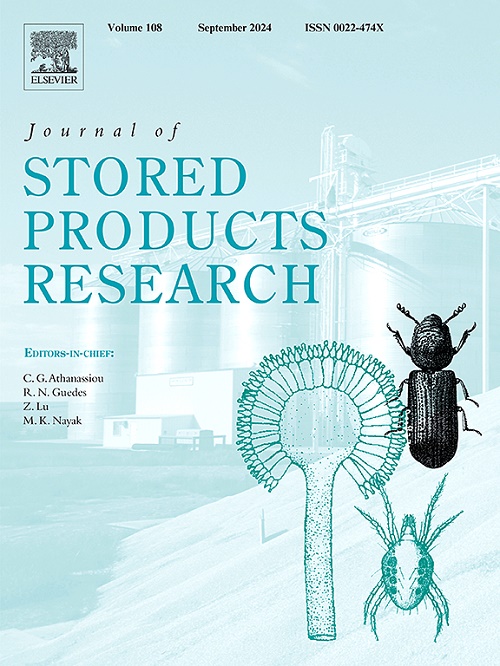在新鲜开心果(Pistacia vera L.)上喷洒甘氨酸甜菜碱以进行冷藏保鲜
IF 2.7
2区 农林科学
Q1 ENTOMOLOGY
引用次数: 0
摘要
贮藏过程中会产生氧化应激,通常会导致果实质量下降,进而降低其适销性。本研究评估了甘氨酸甜菜碱(GB)延长在低温条件下贮藏的新鲜开心果的质量和贮藏期的能力。这项研究的自变量是 GB 的浓度(0、5、10 和 15 毫摩尔)和贮藏期(收获时、收获后 25、50 和 75 天)。随着时间的推移,果仁和果壳中的叶绿素和类胡萝卜素含量、酚类、类黄酮、抗氧化活性、口感、香气、果壳和外壳的外观、坚实度和总重量都有下降的趋势。然而,甘氨酸甜菜碱(GB)能显著防止这些下降。随着时间的推移,GB 能有效抑制果仁中丙二醛、离子渗漏和过氧化氢水平的上升。在 GB 处理过的样品中,与收获时间相比,果仁和果壳中的花青素水平最初都有所上升,但随后又有所下降。GB 增强了过氧化物酶的活性,抑制了多酚氧化酶的活性。然而,与预期相反,GB 会降低苯丙氨酸氨裂解酶的活性。总的来说,GB 浓度越高,效果越明显。根据研究结果,建议在冷藏期间使用 GB(特别是 15 mM 的浓度)来保存新鲜开心果。本文章由计算机程序翻译,如有差异,请以英文原文为准。
Spraying glycine betaine on fresh pistachio fruits (Pistacia vera L.) for preservation in cold storage
Oxidative stress occurs during storage, often leading to a decrease in fruit quality and subsequently reducing its marketability. In this investigation, the ability of glycine betaine (GB) to extend the quality and storage of fresh pistachios stored in cold conditions was evaluated. The independent variables in this study were the concentration of GB (0, 5, 10 and 15 mM) and storage period (at harvest, 25, 50, and 75 days after harvest). Over time, the chlorophyll and carotenoid content of both kernels and hulls, as well as phenolics, flavonoids, antioxidant activity, taste, aroma, appearance of shells and hulls, firmness, and overall weight, tend to decrease. However, glycine betaine (GB) significantly prevents these reductions. GB effectively countered the rise in malondialdehyde, ion leakage, and hydrogen peroxide levels in kernels over time. In GB-treated samples, anthocyanin levels initially increased when comparing harvest time in both kernels and hulls, but subsequently decreased. GB enhanced peroxidase activity and suppressed polyphenol oxidase activity. However, contrary to expectation, GB reduces phenylalanine ammonia lyase activity. Overall, higher GB concentrations lead to a more pronounced effect. Based on the results, GB, particularly at a concentration of 15 mM, is recommended for preserving fresh pistachios during cold storage.
求助全文
通过发布文献求助,成功后即可免费获取论文全文。
去求助
来源期刊
CiteScore
5.70
自引率
18.50%
发文量
112
审稿时长
45 days
期刊介绍:
The Journal of Stored Products Research provides an international medium for the publication of both reviews and original results from laboratory and field studies on the preservation and safety of stored products, notably food stocks, covering storage-related problems from the producer through the supply chain to the consumer. Stored products are characterised by having relatively low moisture content and include raw and semi-processed foods, animal feedstuffs, and a range of other durable items, including materials such as clothing or museum artefacts.

 求助内容:
求助内容: 应助结果提醒方式:
应助结果提醒方式:


